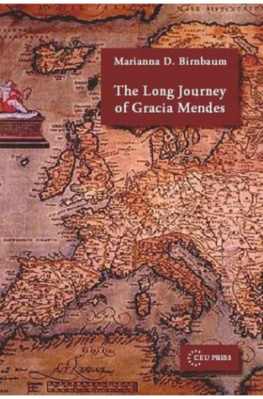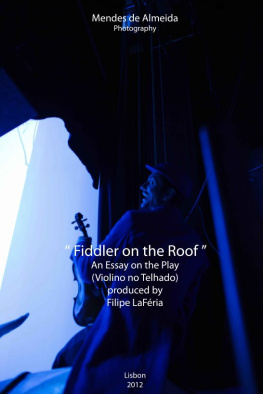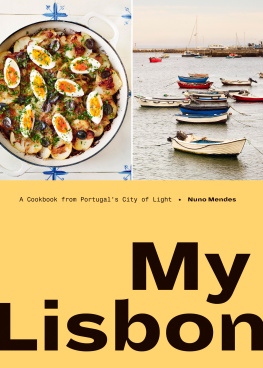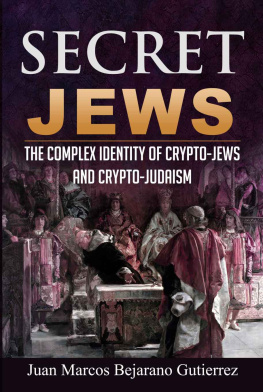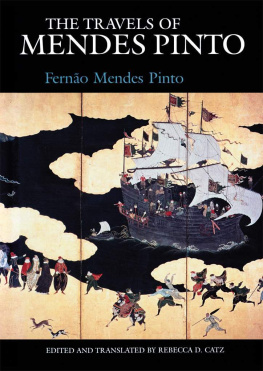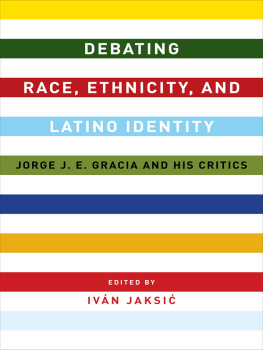
The Long Journey of Gracia Mendes

The Long Journey of
Gracia Mendes
by Marianna D. Birnbaum
Central European University Press
Budapest New York
2003 by Marianna D. Birnbaum
Published in 2003 by
Central European University Press
An imprint of the
Central European University Share Company
Ndor utca 11, H-1051 Budapest, Hungary
Tel: +36-1-327-3138 or 327-3000
Fax: +36-1-327-3183
E-mail: ceupress@ceu.hu
Website: www.ceupress.com
400 West 59th Street, New York NY 10019, USA
Tel: +1-212-547-6932
Fax: +1-212-548-4607
E-mail: mgreenwald@sorosny.org
All rights reserved. No part of this publication may be reproduced, stored in a retrieval system, or transmitted,
in any form or by any means, without the permission of the Publisher.
ISBN 963 9241 67 9 Cloth
Library of Congress Cataloging-in-Publication Data Birnbaum, Marianna D.
The long journey of Gracia Mendes / by Marianna D. Birnbaum.
p. cm.
Includes bibliographical references and index.
ISBN (cloth)
1. Nasi, Gracia, ca. 1510-1569. 2. MarranosPortugalBiography.
3. JewsPortugalBiography. 4. SephardimPortugalBiography.
5. Jewish womenPortugalBiography. 6. JewsEuropeSocial conditions
16th century. 7. JewsEuropeEconomic conditions16th century.
8. EuropeEthnic relations. I. Title.
DS135.P8N373 2003
946.90049240092dc21
2003009770
Printed in Hungary
by Akaprint Nyomda
TABLE OF CONTENTS
Acknowledgments........................................ Vii Chapter 1 INTRODUCING THE FAMILY...................
Chapter 2 A SHORT HISTORY OF THE CONVERSOS.......
Inquisition in Spain and Portugal....................
The Assimilation of Conversos......................
New Attitudes Toward Conversos...................
The Special Status of the Rich...................... 12
Changing Places Changing Names.................. 13
Chapter 3 LIFE IN SIXTEENTH-CENTURY ANTWERP...... 15
Converso Life in Lisbon and Antwerp................ 18
The Family Business............................. 20
Pepper and the Mendes Wealth...................... 24
The Move to Antwerp............................. 26
Gracias Official Entry into the Family Business........ 27
Diogo and the Accusation of Judaizing............... 29
The Emperors Blackmail.......................... 31
The Emperors Matchmaking....................... 32
Chapter 4 GRACIA IN VENICE............................ 36
Conditions in Ferrara and Mantua................... 41
A Sisters Quarrel................................ 42
The Alleged Kidnapping........................... 46
Inquisition by Proxy.............................. 48
Costas Defense................................. 50
Brianda Before the Inquisition...................... 52
Chapter 5 GRACIA AND JEWISH PATRONAGE
IN SIXTEENTH-CENTURY FERRARA........... 54
The Ferrara Bible................................ 56
Meeting an Old Friend............................ 62
The Medal Controversy........................... 63
The Growing Intolerance in Ferrara.................. 65
Table of Contents
Chapter 6 IN BUSINESS WITH RAGUSA...................
Jews in Ragusa.................................. 68
The Ragusan Deal................................ 71
Chapter 7 THE OTTOMAN EMPIRE AND THE JEWS.......
The Legal Status of Jews.......................... 76
Social Life and Customs........................... 81
The Western View of Levantine Jews................. 82
Gracias Arrival in the Ottoman Empire............... 87
Who is a Jew?................................... 89
The Mendes-Nasi Enterprise....................... 90
The Crises in Ancona and Pesaro.................... 93
Leading the Boycott Against Ancona................. 98
New Faces in Constantinople....................... 103
Gracia and the Resettling of Safed................... 106
Jewish Patronage in the Ottoman Empire.............. 108
The Decline of the House of Mendes-Nasi............ 110
Conclusion.............................................. 115
Appendices
Money, Prices, Values............................ 121
From Dubrovnik to Constantinople.................. 125
Select Bibliography....................................... 128
Picture Credits........................................... 141
Index
.............................................. 142
Index of Places.................................. 142
Index of Persons................................. 144
ACKNOWLEDGMENTS
Many years ago, when I was writing about the Fuggers, a famous German banking family, I came across a statement made by one of their business agents, Hans Dernschwam, who traveled widely in the Ottoman Empire (155355). Dernschwam noted that Jews enjoyed a privileged position under Turkish rule; in particular, the head of one family, a Portuguese woman, dared to dress and behave like a European aristocrat, surrounding herself with luxuries and servants.
I made a mental note to return to that passage and look further into the subject, but I forgot all about it until several years later when I attended a lecture on Renaissance medals. The lecturer pointed out that on one medal appeared the profile of an elegant young woman. Encircling her relief were Hebrew letters and her name was transliterated as Gratsia Luna. Could this be the same Portuguese woman whom Hans Dernschwam had mentioned in his diary? Only much later still did I discover that the medal depicts not her, but her niece, who had the same name. The lecturer had erroneously confused the two women and identified the portrait as that of the older one.
By that point, however, I was smitten. Who was that mysterious Seora whom Dernschwam had so viciously disparaged? How did her niece come to have her portrait positioned on the medal? How could the lecturer on medals have made such a major error?
This book is the result of my inquiry into the life and times of that remarkable woman, Seora Gracia Mendes (Luna), who commanded one of the most powerful positions in European trade in the sixteenth century, despite virulent anti-Semitic sentiments that had helped fuel the Spanish Inquisition and that eventually forced her to move with many in her family from Portugal to Turkey.
I am grateful to the Center of Medieval and Renaissance Studies at the University of California, Los Angeles, for having provided me generously with qualified and enthusiastic research assistants. I also wish to thank my many friends, who patiently listened and thoughtfully commented, when I kept bombarding them with those fascinating details I had unearthed about my heroines long and arduous journey from Lisbon to Constantinople.
I hereby want to thank Professors Sima Cirkovicnd Barisa Krekic for
Acknowledgments
providing me with information on the trade routes frequented by sixteenth-century travelers in the Balkans. I am very grateful to Professor Jascha Kess-ler for his many stylistic improvements and to Professor Gabriel Piterberg for his expert comments regarding the Ottoman Empire.
My special thanks go to Dr. G. Patton Wright who helped shape this volume with his many invaluable suggestions.
Next page
